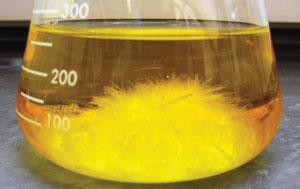Dylan Stiles has powerful recrystallisation voodoo
Dylan Stiles has powerful recrystallisation voodoo
Politics is not my cup of tea, so I don’t usually consider Washington DC to be the most exciting place in the world. Of the few attractions that get me jazzed, I have to recommend the Smithsonian Museum of Natural History as a must-see for chemists. Go straight to the gem and mineral collection, where you’ll find a bright purple amethyst the size of a car. But while minerals produce spectacular crystals of every hue, it’s organic crystals that really matter to me.
When you run a reaction to synthesise some random product, the first priority is to purify it from the unwanted junk (the Complex Residues And Products). Column chromatography is the most predictable solution, and usually the first recourse for those of us in a hurry. But it wastes a lot of solvent and silica gel, so it’s impractical on a large scale.
If your material is a solid, crystallisation is much more fun. The procedure looks easy on paper: suspend the solids in a solvent, heat it up until everything dissolves, then let it cool back down. But not all solids want to crystallise, and success is as much an art as a science. Sometimes the insubordinate material would rather come out of solution as an oil, mocking your futile attempts.
You can try all sorts of voodoo to coax recalcitrant compounds into crystallising, like scratching the side of the flask with a spatula. Supposedly this makes microscopic glass shards that act as crystal seeds. Along those lines, I’ve heard an even more outlandish rumor that bearded gentlemen have better luck crystallising thanks to the detritus that falls out of their facial hair.
Unhelpfully blobby
Nobody knows these tribulations better than the poor souls who attempt to crystallise proteins for x-ray analysis. A protein crystal lattice is best described as a bunch of bowling balls held together with tape. Protein crystallographers are therefore the group most likely to engage in ritualistic animal sacrifice.
Making a crystalline salt of an amine or carboxylic acid is usually the best way to purify it, and here you’ve got the added choice of what counterion to use. Amine hydrochlorides are the classics, but not necessarily the best. Lately I’ve come to be a fan of oxalate and fumarate salts of my amines. You can also make salts with a chiral counterion to resolve a racemic mixture of compounds. To resolve organic acids, this was once done with natural amines like strychnine and morphine, but they’re not used as much nowadays (I wonder why).
Life, the universe and everything
When crystallisation works, it’s a beautiful thing, and certainly one of my favorite pastimes. I like to recrystallise even when it’s totally unnecessary, just for fun. If you’re ever bored, make yourself useful by recrystallising some NBS (N-bromosuccinimide) from boiling water. It’s so simple and idiot-proof that even the undergrads can do it (see below).

First, your hot, supersaturated solution starts to get turbid. A few small specks appear on the surface, beginning to swirl and dance on convection currents. They clump together, growing bigger and bigger until the crystals start to rain down. The golden snowflakes are so lovely you may find yourself sticking your head inside the fume hood to get a close-up view of the action. Within five minutes, that clear solution has turned to a pile of yellow ice at the bottom of the flask.
It’s order emerging out of chaos. This is how stars are born, how lipid bilayers self-assemble - it feels like watching the origins of life, the universe and everything.
Dylan Stiles is a PhD student based in California, US












No comments yet